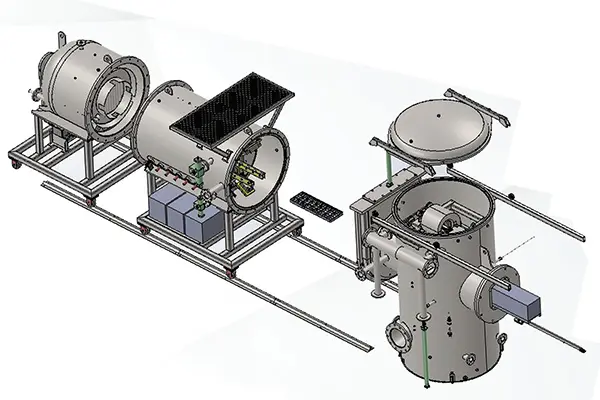 Continuous Vacuum
Continuous Vacuum
The continuous vacuum “CV” furnace essentially transforms a batch vacuum furnace into a straight through furnace. Work is no longer processed into and out from the same side – rather work is loaded into the entry side and unloaded from the exit side of the furnace. Modules consist of load/evacuation chambers, preheat and high heat chambers, multiple heat position chambers, and quench (oil and/or pressurized gas) chambers.
Small batches are indexed in a continuous fashion making this style furnace highly productive in processes that range from annealing, brazing, carburizing, sintering, to hardening. Processing of smaller lots allows for tight temperature uniformity within the working area to provide near identical thermal profiles within the work lot – center to edge. With the continuous vacuum furnace, the heat chamber is not exposed to room air conditions nor is it thermally cycled. It remains hot and under vacuum making for a highly efficient and pure system that enhances part quality.
Designs of the modular “CV” vacuum furnace can produce up to 1500 lbs/hr (680 kg/hr) with temperature capabilities to 2600°F (1427°C).
Metallurgical Processes
Gasbarre Thermal Processing Systems’s very own specialist Patrick Weymer invites you to the discussion, “Modular Vacuum Furnace for an Every Changing World”.
Webinar Outline
Email Us Now About Gasbarre Modular Vacuum Furnaces
Call Today @ 401.467.5200
View Gasbarre’s Continuous Modular Vacuum Brochure
Loading and unloading a continuous vacuum furnace does not interfere with processing and can be accomplished simultaneously. Several loads can be staged at once reducing the attention required from operators. Automatic indexing eliminates the need to program every batch which improves quality control.
In a batch vacuum furnace, the entire insulation assembly must be heated and cooled every cycle. In addition to adding significant energy costs, this increases the time required to thermally soak the workload and slows down quenching. Because the heating portion of a continuous vacuum furnace is held at temperature, only the mass of the work is heated and cooled. This reduces energy consumption and cycle time while also eliminating losses from nozzles and openings required for cooling.
Because the heating portion of a continuous furnace is held under vacuum and at temperature, gas development rates from outgassing and desorption are allowed to decay to very low levels. This reduces contamination from atmospheric moisture and allows for a purer environment without the need to bakeout the furnace between cycles.
Another significant advantage of continuous vacuum processing is reduced thermal wear on consumable refractory materials. Thermal cycling leads to ratcheting, distortion, and premature oxidation. The intrinsic thermal stability and purity of a continuous vacuum furnace reduces spare part cost and maintenance down time.
Because of the larger loads required to achieve production rates in a batch vacuum furnace, it can be difficult to achieve thermal uniformity during transient heating and cooling. The reduced load size in a continuous vacuum furnace means that parts experience a much more uniform thermal profile without sacrificing throughput.
Smaller load sizes reduce the footprint required to load and unload the furnace. Small loads are easier to maneuver and align making continuous vacuum an ideal choice for integration with automated production facilities without sacrificing throughput.